Abstract
A technique has been developed which produces an experimental posterior penetrating eye injury that reproducibly results in traction retinal detachment in rabbit eyes. The standard injury is an incision through the pars plana with vitreous prolapse and incarceration; the wound is then carefully closed with microsurgical techniques. It appears that blood in the vitreous is an essential factor in the development of vitreous traction and of traction retinal detachment. The model, which has been successfully transferred to Rhesus monkey eyes, is considered useful for further histological, electromicroscopical, electrophysiological, and ultrasound studies of posterior penetrating injuries of the eye. Our immediate goal is to assess in a controlled experiment whether pars plana vitrectomy can interrupt the sequence of events leading to traction retinal detachment after a posterior penetrating injury.
Full text
PDF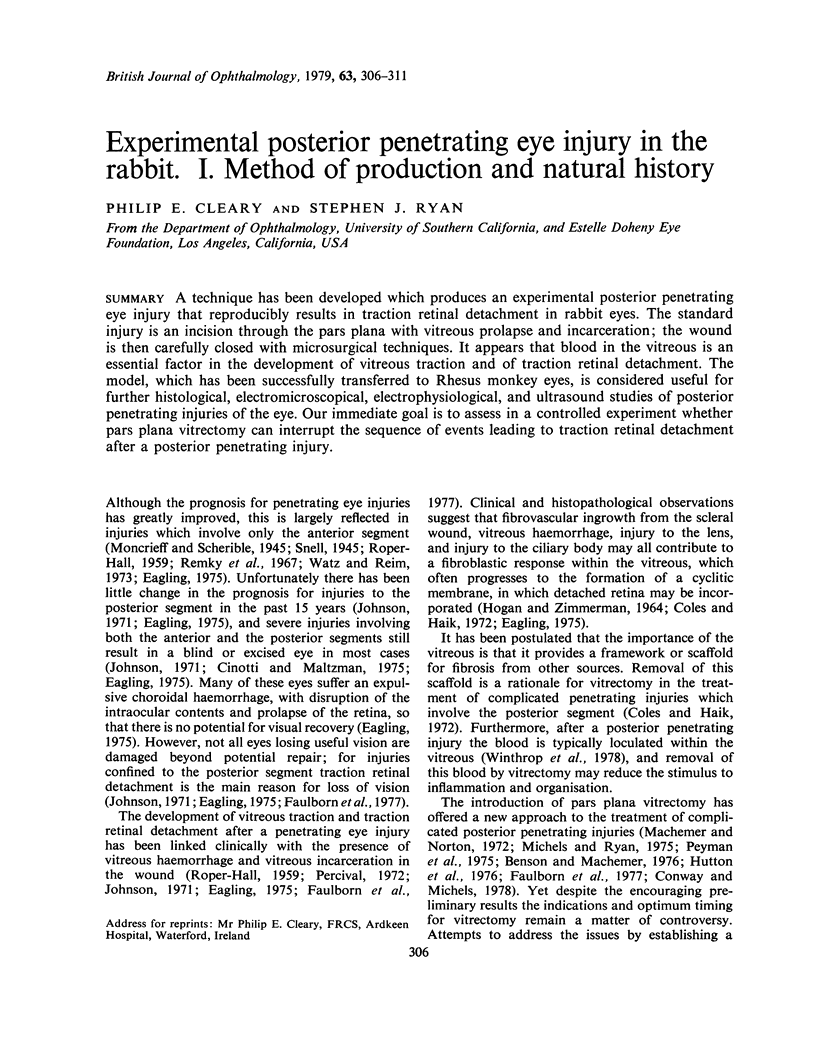
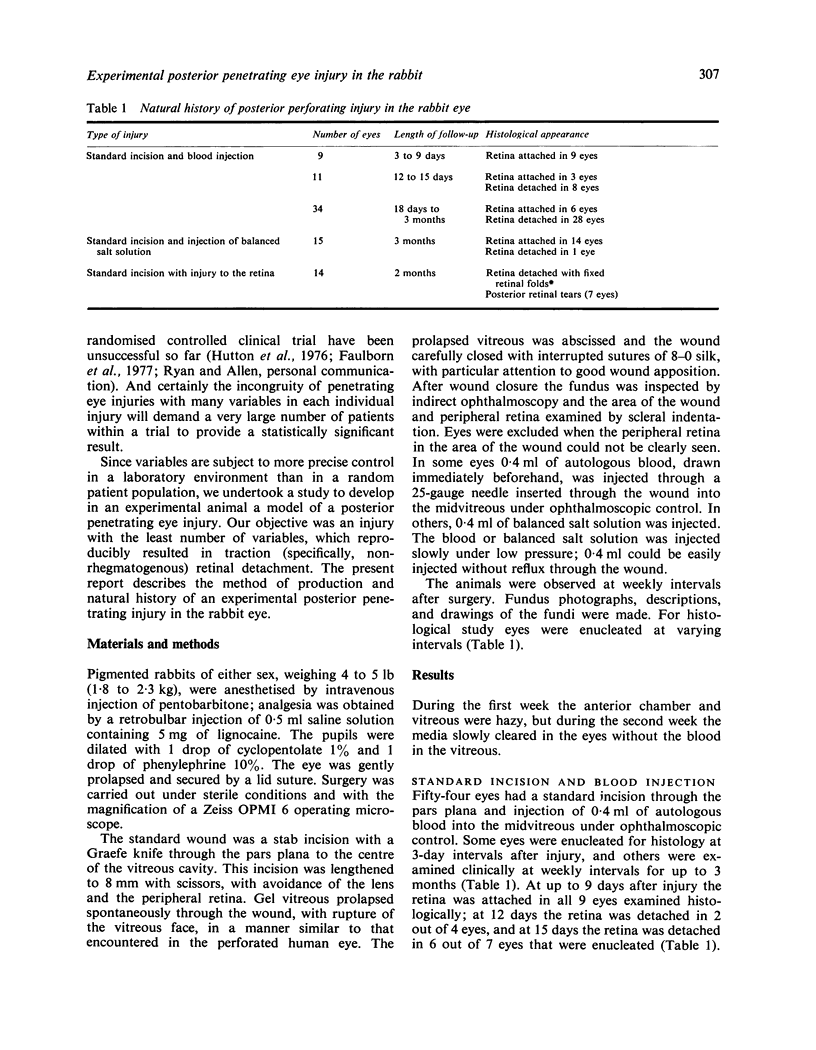
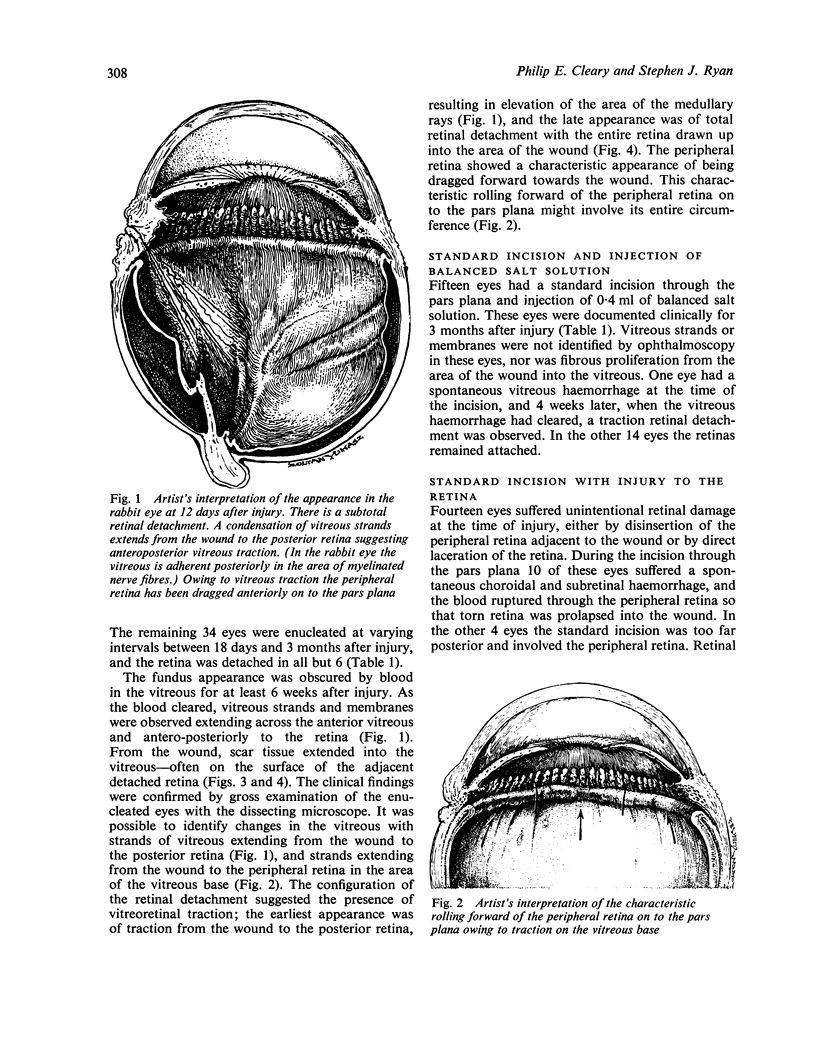
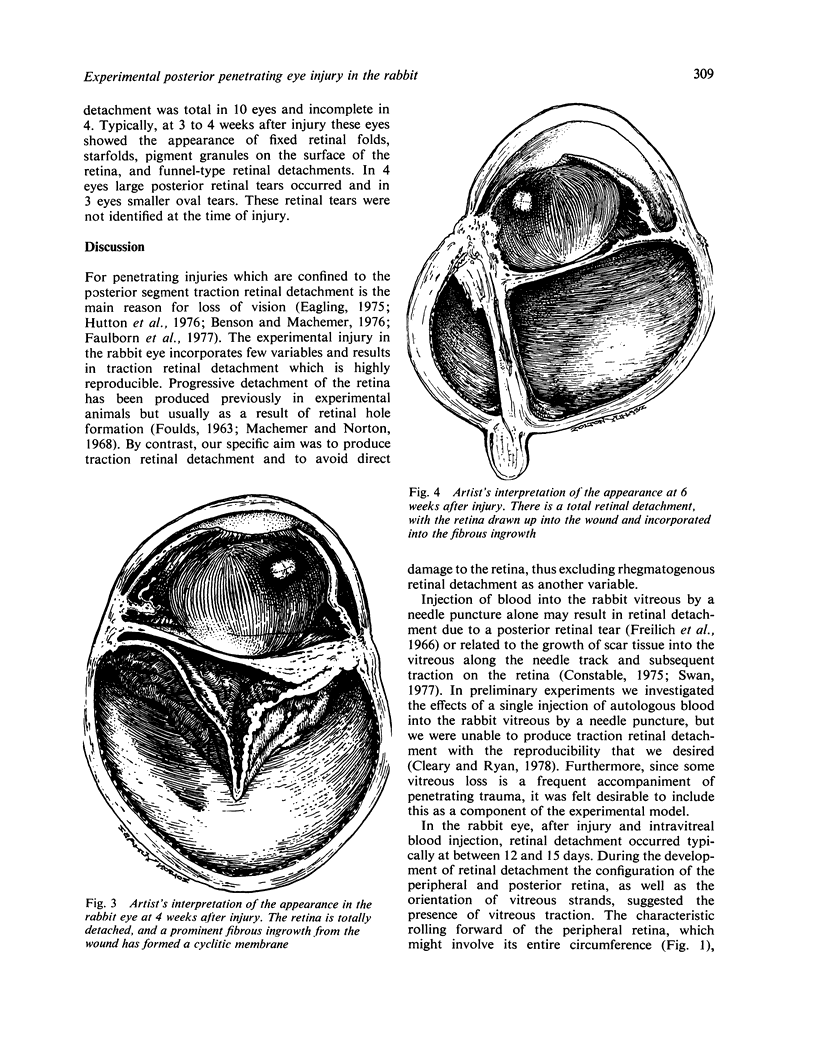
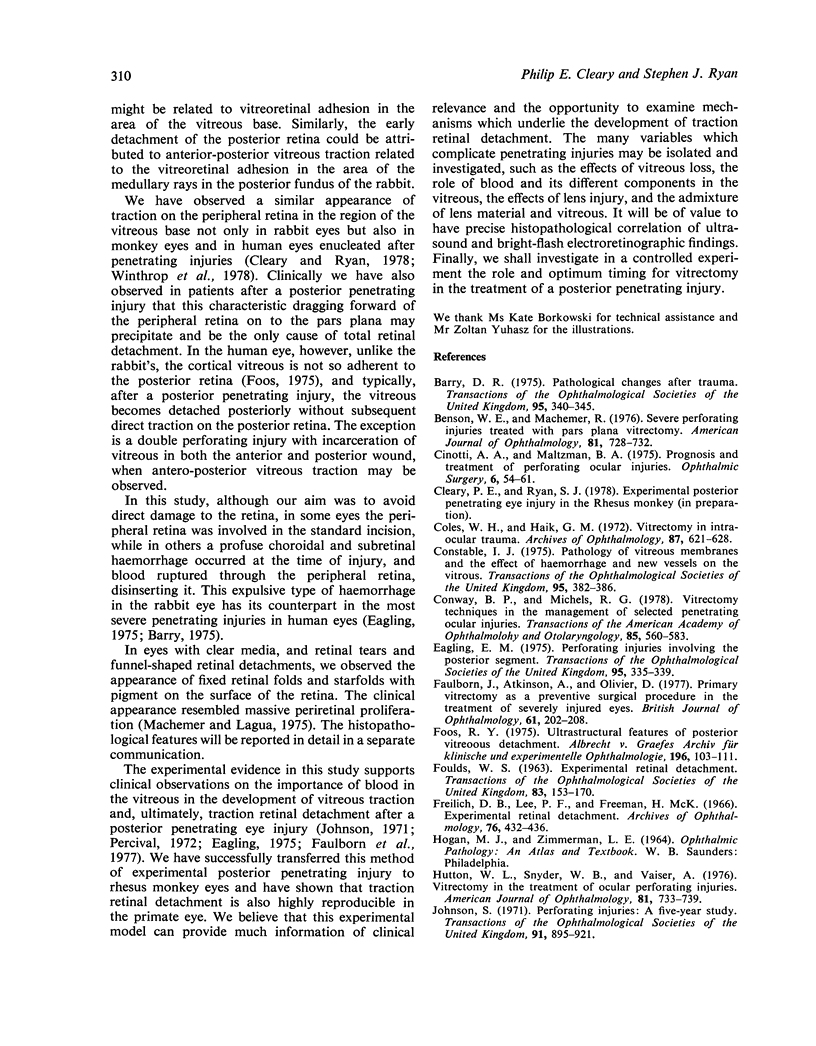
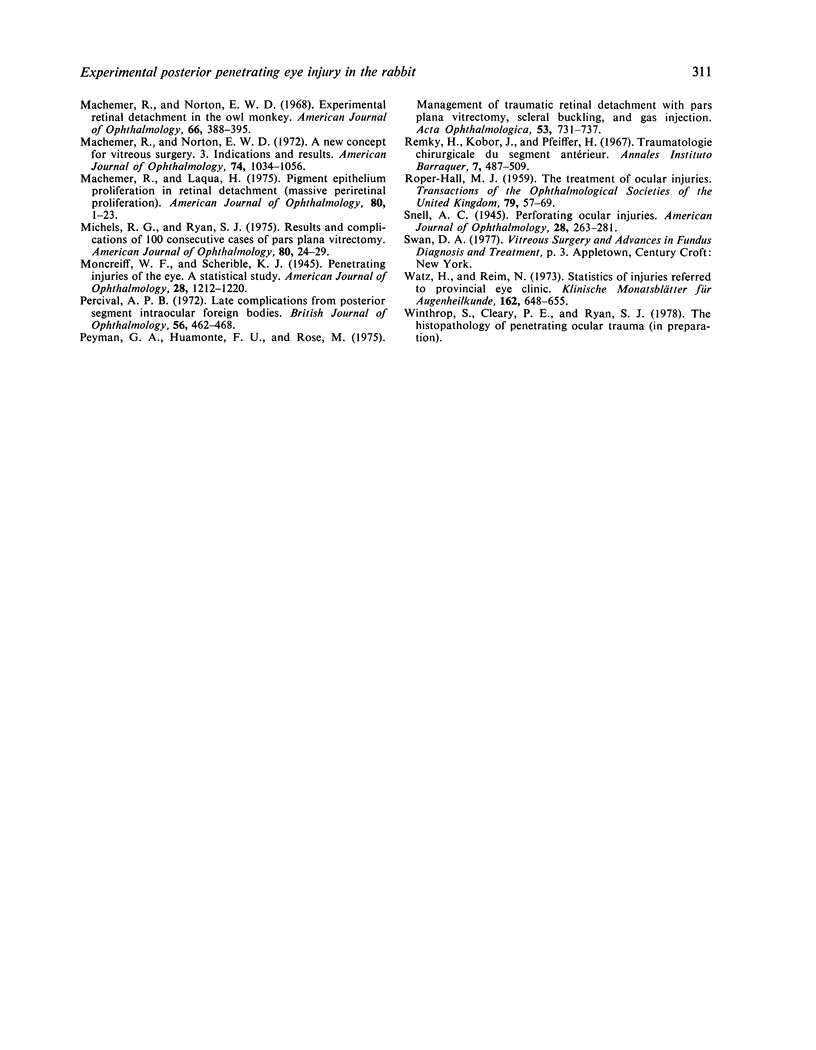
Selected References
These references are in PubMed. This may not be the complete list of references from this article.
- Barry D. R. Pathological changes after trauma. Trans Ophthalmol Soc U K. 1975 Jul;95(2):340–345. [PubMed] [Google Scholar]
- Benson W. E., Machemer R. Severe perforating injuries treated with pars plana vitrectomy. Am J Ophthalmol. 1976 Jun;81(6):728–732. doi: 10.1016/0002-9394(76)90354-8. [DOI] [PubMed] [Google Scholar]
- Cinotti A. A., Maltzman B. A. Prognosis and treatment of perforating ocular injuries. The John Luhr memorial lecture. Ophthalmic Surg. 1975 Winter;6(4):54–61. [PubMed] [Google Scholar]
- Coles W. H., Haik G. M. Vitrectomy in intraocular trauma. Its rationale and its indications and limitations. Arch Ophthalmol. 1972 Jun;87(6):621–628. doi: 10.1001/archopht.1972.01000020623002. [DOI] [PubMed] [Google Scholar]
- Constable I. J. Pathology of vitreous membranes and the effect of haemorrhage and new vessels on the vitreous. Trans Ophthalmol Soc U K. 1975;95(3):382–386. [PubMed] [Google Scholar]
- Conway B. P., Michels R. G. Vitrectomy techniques in the management of selected penetrating ocular injuries. Ophthalmology. 1978 Jun;85(6):560–583. doi: 10.1016/s0161-6420(78)35638-4. [DOI] [PubMed] [Google Scholar]
- Eagling E. M. Perforating injuries involving the posterior segment. Trans Ophthalmol Soc U K. 1975 Jul;95(2):335–339. [PubMed] [Google Scholar]
- FOULDS W. S. EXPERIMENTAL RETINAL DETACHMENT. Trans Ophthalmol Soc U K. 1963;83:153–170. [PubMed] [Google Scholar]
- Faulborn J., Atkinson A., Olivier D. Primary vitrectomy as a preventive surgical procedure in the treatment of severely injured eyes. Br J Ophthalmol. 1977 Mar;61(3):202–208. doi: 10.1136/bjo.61.3.202. [DOI] [PMC free article] [PubMed] [Google Scholar]
- Foos R. Y. Ultrastructural features of posterior vitreous detachment. Albrecht Von Graefes Arch Klin Exp Ophthalmol. 1975 Aug 6;196(2):103–111. doi: 10.1007/BF00414796. [DOI] [PubMed] [Google Scholar]
- Freilich D. B., Lee P. F., Freeman H. M. Experimental retinal detachment. Arch Ophthalmol. 1966 Sep;76(3):432–436. doi: 10.1001/archopht.1966.03850010434025. [DOI] [PubMed] [Google Scholar]
- Hutton W. L., Snyder W. B., Vaiser A. Vitrectomy in the treatment of ocular perforating injuries. Am J Ophthalmol. 1976 Jun;81(6):733–739. doi: 10.1016/0002-9394(76)90355-x. [DOI] [PubMed] [Google Scholar]
- Johnston S. Perforating eye injuries: a five year survey. Trans Ophthalmol Soc U K. 1971;91:895–921. [PubMed] [Google Scholar]
- Machemer R., Laqua H. Pigment epithelium proliferation in retinal detachment (massive periretinal proliferation). Am J Ophthalmol. 1975 Jul;80(1):1–23. doi: 10.1016/0002-9394(75)90862-4. [DOI] [PubMed] [Google Scholar]
- Machemer R., Norton E. W. A new concept for vitreous surgery. 3. Indications and results. Am J Ophthalmol. 1972 Dec;74(6):1034–1056. doi: 10.1016/0002-9394(72)90720-9. [DOI] [PubMed] [Google Scholar]
- Machemer R., Norton E. W. Experimental retinal detachment in the owl monkey. I. Methods of producation and clinical picture. Am J Ophthalmol. 1968 Sep;66(3):388–396. doi: 10.1016/0002-9394(68)91522-5. [DOI] [PubMed] [Google Scholar]
- Michels R. G., Ryan S. J., Jr Results and complications of 100 consecutive cases of pars plana vitrectomy. Am J Ophthalmol. 1975 Jul;80(1):24–29. [PubMed] [Google Scholar]
- Percival S. P. Late complications from posterior segment intraocular foreign bodies with particular reference to retinal detachment. Br J Ophthalmol. 1972 Jun;56(6):462–468. doi: 10.1136/bjo.56.6.462. [DOI] [PMC free article] [PubMed] [Google Scholar]
- Peyman G. A., Huamonte F. U., Rose M. Management of traumatic retinal detachment with pars plana vitrectomy, scleral buckling, and gas injection. Acta Ophthalmol (Copenh) 1975 Nov;53(5):731–737. doi: 10.1111/j.1755-3768.1975.tb01188.x. [DOI] [PubMed] [Google Scholar]
- ROPER-HALL M. J. The treatment of ocular injuries. Trans Ophthalmol Soc U K. 1959;79:57–69. [PubMed] [Google Scholar]


